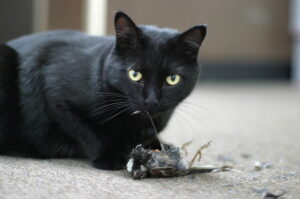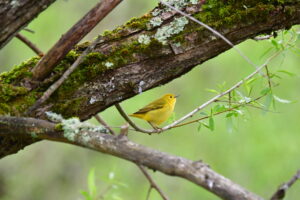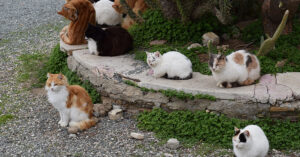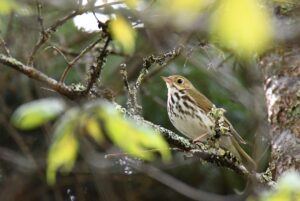
“But why can’t he be an outdoor cat? Maine coons are meant to be out in nature,” my brother said, eyeing Elijah, our then-new cat who has since grown to a size double that of a normal house cat.
“Because,” I said, incredulously, “just look at him! If he gets outside, he’ll eat every single bird from our backyard. It’d be a disaster.”
In that moment, I recalled the grisly sight of a feral cat with a dead Yellow Warbler in its mouth during one of my regular bird walks at Vassar Farm. I thought how that warbler, who had flown thousands of miles from his wintering grounds in Central America to breed at the farm, had had his bright life snuffed out by a hungry feral cat.
I also wondered how many people would shrug at the death of the warbler because of our tenacious cultural attachment to cats.
Elijah is now three years old and enjoys his life as an indoor cat, hunting squeaky toys rather than wild critters. If we’d allowed him to grow up into an outdoor cat, he’d be no different than any of our country’s enormous population of feral cats—a death knell for many common and threatened native species of wildlife in the U.S.

Exact estimates vary, but various sources report that there are between 50 and 70 million feral cats in the United States. Some reports point to figures above 100 million. That’s a lot of cats, considering American pet owners only registered 94.2 million pet cats in 2017.
But why are these cats so acutely problematic?
A 2012 study estimated that a single feral cat kills 23 to 46 birds per year—25% of which they don’t eat—and an outdoor pet cat can match those figures. This means that the U.S. feral and outdoor cat populations combined can rack up 1.4 billion to 3.7 billion bird kills per year. That’s a far higher toll than the still-significant 600 million birds killed in window collisions and up to 340 million killed in vehicle collisions every year.
The total across all species of wildlife is even more grave: when reptiles, amphibians, and small mammals are included in the tally, scientists estimate that feral cats in the U.S. kill 6.9 to 20.7 billion animals annually. Outside of human-driven habitat destruction, there is arguably no greater threat to small wildlife species—especially birds—than feral cats.
So what’s the solution to this big problem? Well, that depends on who you ask.
Many scientists in government agencies and private research institutions argue for a cull: a coordinated effort to trap and euthanize as many feral cats as possible. To any cat owner, however, that plan is a hard sell. After all, it’s not the cats’ fault that they have become so ecologically problematic—that’s on us, the humans who since 1492 have let cats loose on the Americas and done little to hinder their spread.

Until early civilizations domesticated wild cats around 10,000 years ago, small felines (like lynx or ocelots) existed in very low numbers in their natural environs. Until 500 years ago, native wildlife in the Americas didn’t have to contend with the immense predatory pressure of Felis domesticus. Now they do.
Vocal feral cat advocacy groups, however, reject the very notion of culling efforts. They argue that feral cats are simply living an unproblematic “natural lifestyle.” And while some dispute any deleterious effects of cats on native wildlife, they generally agree that an enormous population of feral felines isn’t great. Their solution? A straightforward strategy of “trap, neuter, and return,” or “TNR.”
The TNR model is just that: trap feral cats, neuter or spay them, and return them to the environment. A feral cat can have up to three litters or a dozen kittens per year, so spaying a single female can have a big impact on reducing cat numbers. This strategy sounds like a viable, humane solution—until you think about the downsides.
First, feral cats can live for up to a decade, meaning that even after an individual is neutered or spayed, a cat will still kill wildlife for the rest of its life. Second, the strategy is expensive and time-consuming, necessitating extensive training, as well as the involvement of licensed veterinarians. The companion strategy to TNR, mass adoption, is not always possible with wild-reared cats who have no history of human socialization.
No one wants to kill animals—especially intelligent, culturally important ones like cats—when it’s not necessary. But with feral populations on the rise, we might not have much choice aside from culling.
Some countries have already moved to make that tough choice. Australia implemented a highly-controversial cat cull program in 1999 which has met with some success: since 2015, it’s removed more than 200,000 cats per year from the Australian outback, a region which has been ravaged by feral cats as well as a plague of rabbits for decades. A large proportion of those cats were shot by private landowners and hunters, decreasing the costliness of the program to Australia’s environmental agencies. The Aussie government’s key messaging tactic has been to call feral cats what they are—an invasive species—and that’s worked pretty well so far.

Aside from the expected criticism from groups like PETA, there has also been some scientific criticism of Australia’s cull. As some ecologists accurately point out, feral cats quickly recolonize areas after culls are conducted; thus, continuous monitoring is required. Additionally, they note that the scattershot scope of Australia’s culling strategy has ignored the fact that some endangered species—like the Eastern Bristlebird—should be prioritized when choosing areas in which to conduct culling activities. Instead of encouraging a diffuse national program, resources should be focused on areas where the cats’ impact is most pronounced.
If the U.S. is to adopt such a strategy from the Australians, it must learn the right lessons: educate and involve the public, and keep endangered species in mind. Where culling is not possible, supplementing TNR is certainly a better solution than no intervention at all.
Culling programs are slow to make their way into official policies in the U.S., and like many causes on municipal dockets, the issue is unlikely to gain any attention or traction during the global COVID-19 pandemic.
In the meantime, the best thing you can do—aside from keeping your kitty indoors—is to have the tough conversation about culling. Confront popular notions about cats’ role in our ecosystems, as I did with our cat Elijah. Feral cats may not be far removed from our indoor housecats, but they are a different animal altogether when it comes to the threat they pose to our native wildlife.

“Love the Cull”??? wow…genocide much?! I have an indoor cat that requires a nightly outdoor stroll or he’ll tear my apartment apart. So you’re promoting he be shot by people who’d love the chance to sadistically kill him and any other occasional outdoor pet. By the way, he’s not even my cat. He was left behind by an irresponsible neighbor. After being outside in 119 degree heat he broke into my apartment for shelter and has lived with me since then. I neutered and chipped him but still let him roam as that’s who he is. Yes he’s brought me an array of wildlife including mostly pigeons, roaches, lizards, giant moths and one rat. I don’t know the value of these animals to the local Phoenix AZ ecosystem but I know landlord exterminates for them. I also care for 12 ferals who’ve been TNR’D. The investment volunteers have made in my complex alone took our outdoor cat population from 120 to 30. We have proven TNR is effective and have protection ordinances for free roaming cats. A TNR’D colony will maintain itself while killing cats only makes room for new cats. Please do some more research on your “love” of the cull and promote a more viable solution.
Did you even read the article? Its not a genocide, the destruction of a entire genus its the culling of excess cats who are killing billions of birds a year. Sorry you dont feel other animals have a right to life as well. The job is to bring into balance. Cats are not native to the US. They will quickly go out of balance and reek havoc on the environment. TNR is not effective because they are still killing billions of foundation animals for the ecosystem. They need to be liquidated, it is the only solution because you arent going to neuter or spay 100 million feral cats. What needs to happen is a licensed bounty on cats. The problem will be finished quickly. You just dont understand the depth of the problem. Bless your little heart. You shoudnt have to.
So you’re part of the problem allowing your cat to go out and kill at will and I bet it doesn’t even eat them like feral cats do. If it needs to go out put it on a leash and walk it like people with dogs do.
TNR is effective ONLY if (a) it’s available in numbers *commensurate* with the local feral population, and (b) if at least 85% of the public in a given community participates. I have a large colony of sterilized cats, and all it’s done is attract other cats (“owned” and free-roaming) from all over, which are *unmanageable*; I love and care for mine like my kids, but had to learn the hard way.
The fact is that the US does not need to learn from these efforts because research thus far (including in Tasmania in 2015 and more recently in New Caledonia in 2020) shows that culling is not effective. Education, yes, is desperately needed and has to be ongoing. One of the biggest problems relates to house pets that are not spayed-neutered and are occasionally allowed to go outside, or that escape, or that are abandoned by their owner. No amount of culling will solve those problems. Further we need much greater government support and spending so that efforts such as TNR can be accomplished much more effectively.
Fantastic article. I have been reading about this feral cat problem for decades. I have a binder about 3 inches thick of articles. I have attended city hearings on the feral cat problem and witnessed the crazy behavior of the feral cat feeders, which makes me wonder if they are not suffering from toxoplasmosis. They are full of emotion but not very full of wisdom about the feral cat problem. AND, I like cats! I just don’t like them running around outside killing birds and small animals and herps. We do need a serious feral cat cull in the USA. Thankfully, in the regions populated by coyotes, they are doing a good job of taking out feral cats. I am posting this article on my facebook…DAILY if possible.
While they certainly help, unfortunately the coyotes (at least where I live) are not sufficient. I’ve trapped two ferals this morning… one was caught 20 minutes after I deployed the trap. Animal Control does what they can to help but it’s not sustainable in the least. While I also do not hate cats, the feral population in my area is exploding and they decimate the wildlife. My dogs, which are well-trained and never leave my property, are in constant danger of contracting toxoplasmosis and who knows what else. Never thought it would come to this but I’m currently researching the most humane method of euthanizing them after trapping.
it is a violation of animal cruelty laws in virtually every jurisdiction to wound or deliberately kill a cat. It’s unfortunate that you find the presence of these animals a personal inconvenience.
It’s not a personal problem when these non-native species are killing the ecosystem!
Your job is cut out for you. The feral cat problem is serious. I have read that experts think 50 percent of the US population has toxoplasmosis in one form or another. I do know that when young kids get it that by the time they enter their early twenties they tend to develop schizophrenia as a result of the effects of the parasite on their brains. Now, this is a situation which is totally ignored by the feral cat feeders and those who want to return them to the outdoors. In fact, it is not addressed. However, military bases with families living there keep cats away from the playgrounds and the sandboxes for kids in order to keep cat feces away…as the parasite is in the feces and can infect the little kids in the sandboxes.
i love how little cats’ lives matter to so people. why don’t we talk about the harm humans are doing on the planet and the government starts mass slaughtering them?
I was an animal control officer for a large county in California for five years. Our shelter euthanized hundreds of cats every month in the 1990s and hundreds kept coming in. It was a continuous never ending cycle. I can tell you from experience that euthanizing or culling cats isn’t the answer. I agree that the TNR program is a far better solution. It’s less traumatizing for the cats versus being euthanized and won’t take as heavy a toll on the mental well being of those doing the euthanizing. The TNR program saves local counties money that would otherwise be spent on boarding, feeding, keeping the cats warm in the winter months, medicine, extra employees and euthanizing. TNR volunteers are saving local governments and tax payers money. I believe that cats fight for territorial rights and therefore will chase other cats away. Removing cats and euthanizing won’t end the cycle. New cats will move in. However, some people who are fed up with dealing with cats will poison, shoot or dispose of feral and pet cats however way possible. The feral cat population is taking a toll on pet cats and around 20 pet cats have disappeared in our city in the past year including my own two indoor fixed cats that ran out. Volunteers are paying out of pocket to TNR and making appointments to spay or neuter for low cost programs is becoming more difficult. The money that the local governments save because of TNR need to be allocated to TNR programs. The government needs to get more involved in the TNR program for it to become fully effective. Spaying and neutering laws should become state law in California. I can understand how people feel. No one wants to find cat feces in their child’s play area or on the lawn and flowers beds. Feral cats hang out on people’s roofs and I have to worry about my dogs looking for cat feces to eat. I think it all comes down to the government getting more involved.
Every cat that wonders up and stays around our country home is trapped and neutered or spayed. I have 3 in the house and 3 outside. Stray vs feral is a dilemma. Most strays are dumped, some ferals are dumped, but most of them come from mommas that were dumped. I don’t believe in culling, it doesn’t work and it never will. Bobcat fever works for a year or two. At one point all the cats in our area died. It was about two years before any more showed up. The problem is not cats, it’s people. I hear all the time how our population is declining. I am glad to hear that, but the damage of too many people continues to progress, and will continue to because we have no idea how to live in-tune with our surroundings. We blame the cats like it’s their fault that they are here. Who introduced them to the environment, people. Who takes up so much area that it pushes wildlife into living areas, us. I love listening to people talk about something that they all have an opinion on. The bottom line is we are the parasitical entity here not the cats. If we weren’t here, it would all play out as nature intended.
Pingback: The Average Age For A Cat To Reach Sexual Maturity Is 5 Months Old – Hyaenidae
Who are you, God of the animals who gets to decide who has more “right to life”? Using your logic, maybe we should cull humans since they pose a million times more of a threat to biodiversity than cats do. Why don’t you just worry about your own species and leave cats alone.
You cannot control cats & you can’t force them to just stay inside of a house all the time! Cats can be trained I’ve done it…they will stay in the yard or close newbies but if it’s going to come to me worrying if my cats going to be shot dead in my own neighborhood someone’s going to pay big time for that! You leave cats alone! Just TNR! Responsible people TNR! You will do your community a huge favor if you TNR! I know an auto business & all of these macho man that work on cars have pet cats next to them and they have no rodent problems, and the cats have all been captured spayed and neutered and released, and they feed them and water them and their their pets, and the circle of cats is not getting any bigger! It’s proven that they are doing the community a big favor by doing this! TNR WORKS I’ve seen it in all of my neighborhoods that I live by! TNR works the best, & there are a lot of vets will volunteer!
Should be required to license a cat just like a dog and require a collar on the cat so people know it’s a cared for pet then cull the ones not collared as feral . The problem has to be dealt with as bird varieties are facing extinction from these unwanted animals that are not native . If you have a better solution post it
I applaud the author for bravery and most importantly integrity. So many of these comments are wild. “Who are you to decide who has a right to life” Bruh millions of invasive predators is not a neutral, default state.
Question: isn’t it the humans who domesticated cats in the first place then abandoned them into the wild? It is by the hand of countless irresponsible dumb humans that started this in the first place! I hope whoever slaughters them, poisons them, shoots them etc,. Is overrun with large rodents cuz that’s a problem too! How much money is spent on the stupid sausages they drop by airplanes? How much are they paying all of these demons to murder them? It’s not culling it’s murder for them simply existing! They are just being their natural selves. It’s not their fault they were born. The money is being wasted….cuz TNR is a much better & only method to prevent, DUH!
Allison, There are plenty of native species to take care of rats…like hawks and owls for instance. Those rats are their food. An owl will hang around a barn or shed if there are rats about. Meanwhile, BILLIONS OF NATIVE BIRDS ARE KILLED BY CATS EVERY YEAR. Now, that is wrong. It is illegal. It is EVIL. Cats do not belong outdoors running around. Not only that, it isn’t safe for the cats…who can catch feline disease, and TOXOPLASMOSIS, which is dangerous for humans and all animals. Toxo is a serious concern which is being ignored by the public.
Toxoplasmosis can be acquired by eating undercooked meat!!!!!
Can someone please tell the hundreds of European starlings that stop at our house every year in January & stay for several weeks during their migration that they are not native birds? They poop everywhere! Giant splashes of poop all over our deck, patio & house.
Can someone please tell the red tailed hawks & owls to stop killing the sparrows(house sparrows mind you which are non native), nuthatches & bluebirds in our yard?
Can someone please tell the woodpeckers to stop drilling holes in the siding of our home? I know that there are wasp nests that they are trying to get to, but we don’t use pesticides here.
We have spent countless hours cleaning up & lots of money cleaning up after birds as we’ve been feeding them for years.
Our neighbor’s “friendly” dog killed a cat in our backyard in front of us.
Another neighbor’s dog killed several adult rabbits in their yard.
Another neighbor’s dogs kills birds whenever the opportunity presents itself.
Yes, cats are destructive. But so is almost every creature in nature! Human beings are at the top of that list!